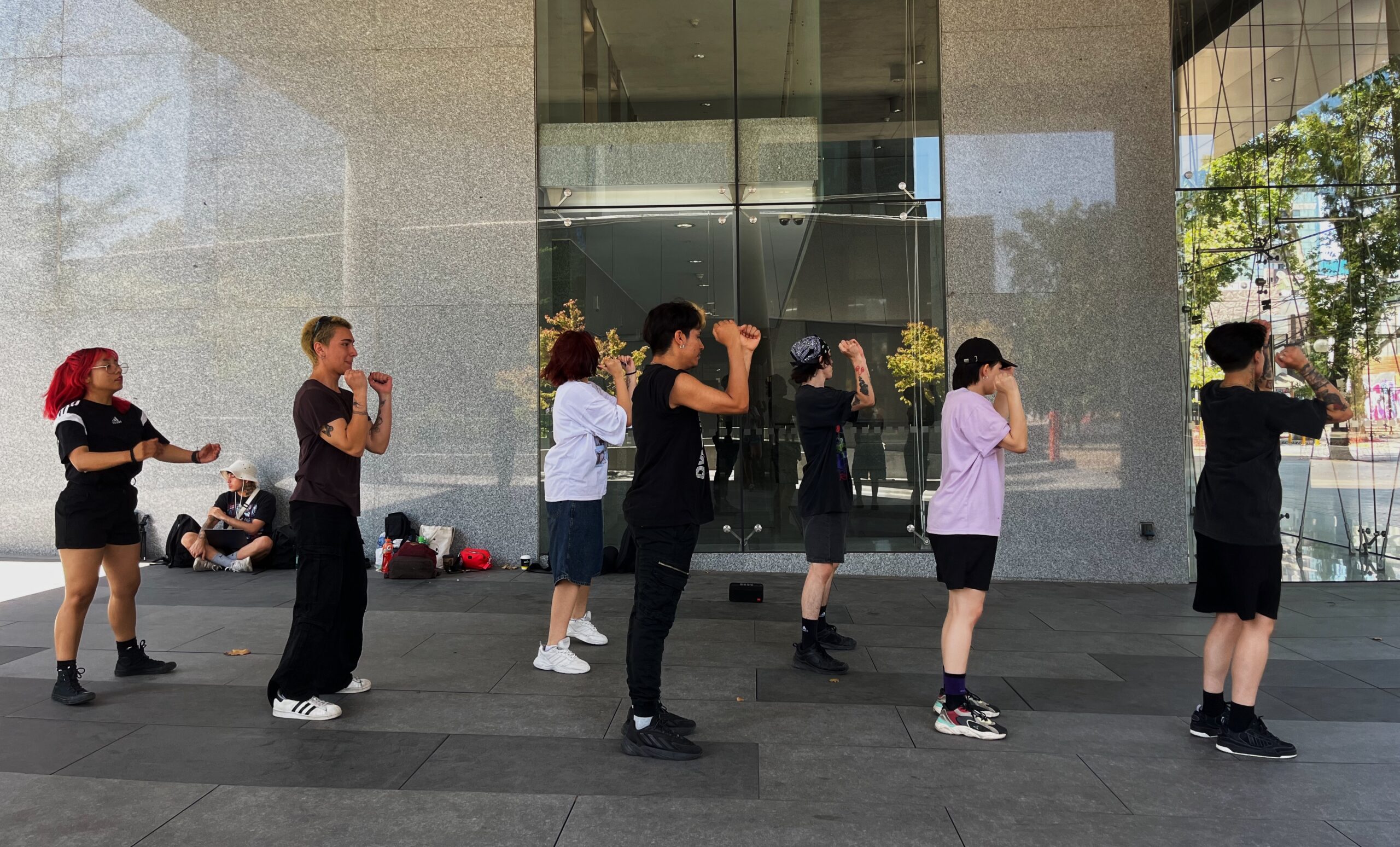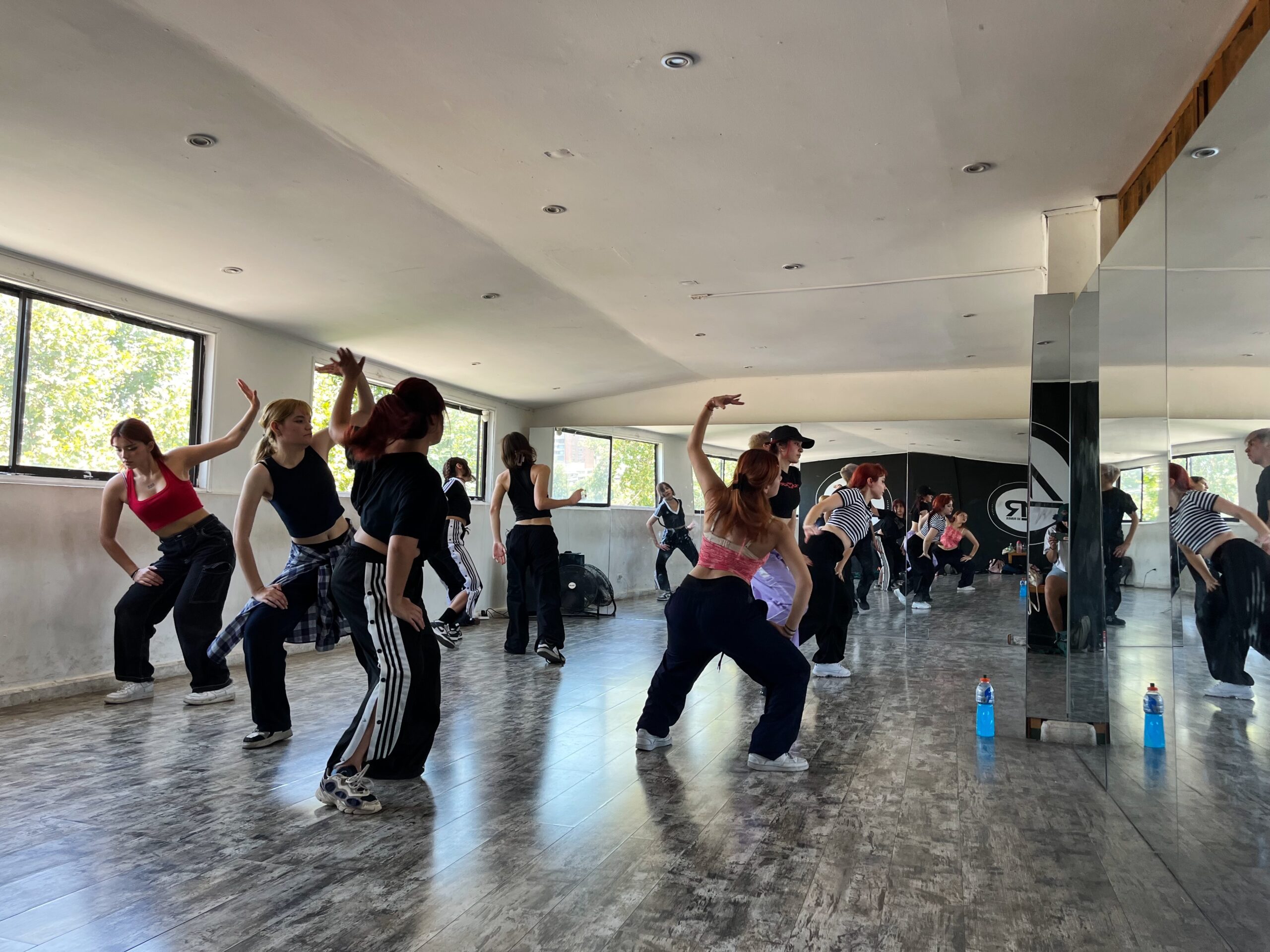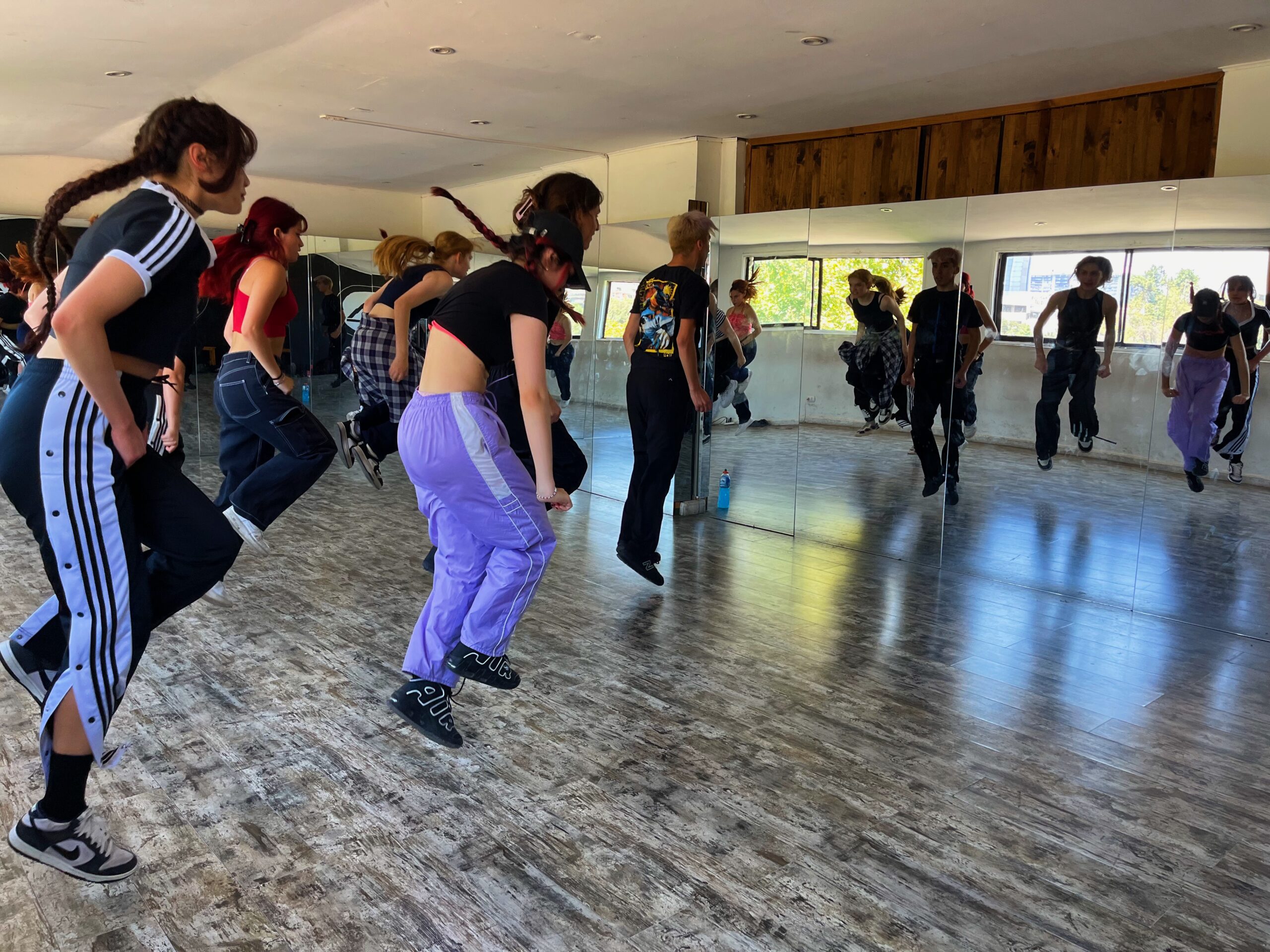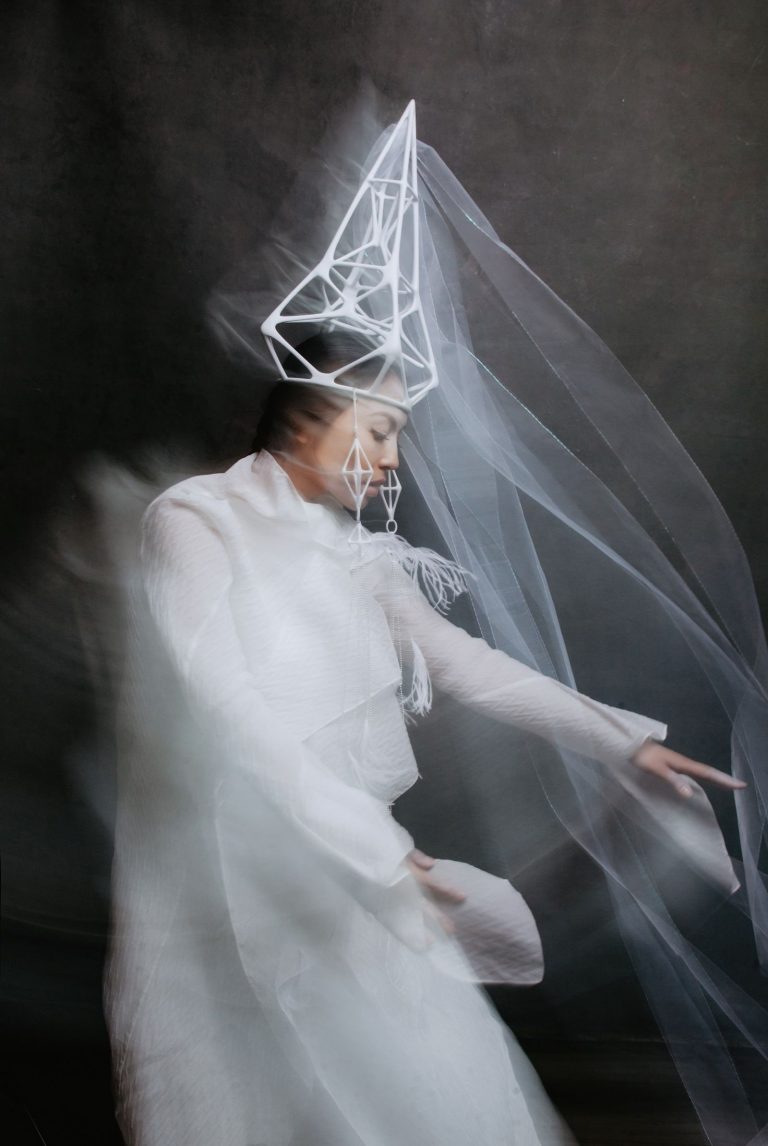On the weekends, the streets of the financial district in Santiago de Chile typically lie deserted, and the towering office skyscrapers adorned with tall glass windows dim their lights until the humdrum of Monday morning resumes.

But since the COVID-19 lockdowns ended, the area has unexpectedly transformed into a massive weekend dance studio, populated by a burgeoning Santiago sub-culture: K-Pop dance cover bands.
The groups can have four to fifteen members, depending on the K-pop group they emulate. The choreography is physically demanding, characterized by high-energy moves, dexterous precision, and complex group dynamics and formations with rapid footwork.
In the world of K-pop, performance is just as important as music.
“It’s not just about dressing like a character,” said Diego Rodríguez, a 22-year-old physical education student. Rodríguez goes to the financial district every Sunday to rehearse with Masterpiece, a dance group covering the K-pop boyband ATEEZ.
“There’s the choreography, personification, an intro, outro, a break between. It’s really demanding,” said Rodríguez.
A booming industry
There’s plenty of evidence of the country’s steadfast craze for K-pop. When pop heroes BTS played their debut in Chile in 2017, they broke records, including one for the fastest show to sell out at Santiago’s Movistar Arena.
They also broke the record for the loudest sound ever recorded in the venue, as fans’ hysterical screams reached 127 decibels.
The Music Bank World Tour — a South Korean festival that brings K-pop bands to international audiences worldwide — went to Chile three times in its thirteen-year history, more than any other country.
The group Masterpiece consists of eight members, each assuming the role of a character in ATEEZ. Rodríguez is Wooyoung. He sits in a semi-circle with the rest of his group. They’ve just finished a grueling two-hour rehearsal perfecting moves for ATEEZ’s single Crazy Form.
The building offers shade and mirrored windows for the band to practice their moves. But the temperature is still above 30 degrees (86F).

Still, each group member commits to practicing despite this summer’s record-breaking heatwave. Masterpiece is one of Santiago’s premier dance cover bands. They’ve won top place in the city’s numerous K-pop dance competitions.
“We do really well in competitions,” said Catalina Contreras, a 24-year-old professional dancer who dances as Yunho in the band. “But it puts pressure on us, and that tainted something that we like doing.”
For Contreras, some of her favorite performances are when ATEEZ fans book them for events.
“The fans know all the songs. They’re shouting and singing at us. The environment is a real motivation,” she described.

Korean culture is disruptive
Janice Tapia, an associate researcher at the Korea Comparative Studies Center at Chile’s Central University, says Chile’s sizeable K-pop fandom goes beyond anything superficial.
“Geographically, Chile is as about as far away from South Korea as you can get,” she explained. Tapia argues that this distance is an essential factor in the country’s love of South Korean culture.
“Chile has been very strongly influenced by the U.S., so there’s an idea that Korean culture is disruptive, something different from the U.S. or Europe,” she said. “Maybe we view South Korea as a more underground or minority culture.”
Tapia also observes that both South Korea and Chile are conservative countries. Chile was one of the last countries in the world to legalize divorce. Equal marriage rights became law only a year ago. Meanwhile, South Korean law does not recognize same-sex partnerships.
Abortion in Chile, a country with Catholic values, can only be accessed in strictly limited circumstances. The government decriminalized abortion in South Korea as recently as 2019, but it remains stigmatized with curbed access for women.
For many in Chile, South Korea’s pop culture provides a liberating outlet. “The K-pop fandom is mostly composed of women or queer people,” Tapia said. “It’s a place where, a lot of the time, people feel safe and can express themselves. They’re not interested in labels.”
The example rings true with Masterpiece. While ATEEZ is a boy band, the majority of the dance cover group members are women.
“It’s about the essence, the vibe of a person,” said Contreras. “You don’t need to resemble them physically.”
Entertainment and accessibility
The fact that K-pop cover dancers perform primarily in public spaces means it’s an accessible form of entertainment for most Chileans from the country’s middle classes and more vulnerable segments of the population.
The most successful dance cover band in Chile is Solider. Two of their eight members come from La Pintana, Santiago’s poorest neighborhood, including Soldier’s leading member, Martin Silva.
In 2022, Soldier beat over 400 teams from 100 competing countries, traveling to win the K-pop World Festival in Changwon, South Korea, the most coveted prize for dance cover acts. Their win made headlines in Chile and led to a meeting with Chilean President Gabriel Boric.
Fernando Herrera, a member of Solider, told the newspaper El Pais that Soldier could be “an example” for the neighborhood.
“We can’t go around drinking or taking drugs. We are changing the community. Even if it’s just one person in 10,000, we can show them that there are opportunities,” he said.
Tapia stresses that a core part of the K-pop fandom lies in its “meritocratic ideals.”
“Many of the young people who dance point out that this helped them have a healthy and happy environment,” she said.
Dancing in the streets
In Santiago Centro, a few kilometers away from Masterpiece’s rehearsal spot, Catch the L1ght is going over its routine in a dance studio.
The booming popularity of dance cover bands on the streets around Santiago has forced them to book a secured studio slot.
“It’s been very difficult to find a place to dance during the weekends,” said Victoria Quezada, a 22-year-old psychology student.
Catch the L1ight is a dance cover band of Kep1er, a K-pop girl band. There are eight members in the group, and Quezada plays Mashiro. She said that this year, they’re looking to win competitions.
“We have to do the choreography, the intros, the wardrobe, make everything ready for a show, to bring it to the competitions,” she said.
They’ve been working on a dance cover of Kep1er’s song ‘The Boys’ (originally a hit by Girls Generation) for roughly six weeks.
“We like to compete. It incentives us to clean up the choreography, make it perfect, and up the energy,” she said.
In 2017, the New York Times wrote about the unexpected rise of K-pop in Chile after the furor of BTS’ arrival in the Chilean capital during their Wings tour. Since then, the passion for the genre has continued to grow.
“In Chile, there’s a really strong admiration for Asian culture, especially Japan and Korea,” said Fernanda Contreras, a 29-year-old Japanese-English translator (Xiaoting in Catch The L1ght). “That comes down to anime and K-pop.”
Agustin Díaz (Dayeon), the band’s youngest member, remembers hearing a song by the K-pop band Twice when he was only 12 years old. He is now 16.
“I was like, Wow! I love music that sounds happy and fun. I couldn’t get it out of my head.”
K-Pop is multisensorial
The dancers say the Korean-Spanish language barrier is not a problem.
“K-pop is very visual, auditory, it’s multisensorial,” said Quezada. “There are fans who don’t listen to K-pop songs at home, but dance K-pop because the choreography is super entertaining.”

The dancers say that K-pop in Chile always had platforms that responded to the budding culture, amplifying its visibility and expanding the fandom.
“I remember seeing a Black Pink dance cover band on morning television years ago,” said Contreras. “They were just starting, very basic, but we watched that and thought, ‘We can meet up and dance K-pop!’”
No going back
Despite K-pop’s current popularity, the members of the Catch The L1ght have weathered odd looks and mean comments, especially the younger members who began to dance during school breaks with friends.
“I liked dancing to female K-pop bands, and they called me gay, asked why I danced like a woman, and I just wanted them to leave me alone. It was a bit hard,” said Díaz.
Paola Brito, who is 17 (Bahiyyih), agrees.
“There were some not very nice comments at school, and K-pop was hidden for a while because of that,” she said
But the dance cover world is quickly shifting from being part of an overlooked sub-culture to earning appreciation from society.
The professionalism and popularity of dance cover bands like Solider and Masterpiece have given the groups broader recognition in the country.
“Now I am not so embarrassed to tell people that I dance K-pop. People say, ‘Ah, that’s cool,’” said Sofia Gallardo (Xiaoting), a 22-year-old student. “Before, they used to be like, you do what?”

Back in the shade of the multi-story office buildings, Masterpiece reflects on K-pop’s popularity in Chile and their commitment to it.
“I always say K-pop is a never-ending hole. There’s no way out!” said Contreras.
Like other members of the Masterpiece, Contreras gives K-pop dance classes and has successfully professionalized her passion for K-pop.
“It’s such an interesting culture,” she reflects. “Once you fall for it, there’s no going back.”
Charis McGowan is a freelance journalist based in Chile. She writes about women’s and gender rights issues, pop, politics, and everything in between.
This journalism was possible thanks to the generous support of George Mason University’s Mercatus Center and its Pluralism and Civil Exchange program.







